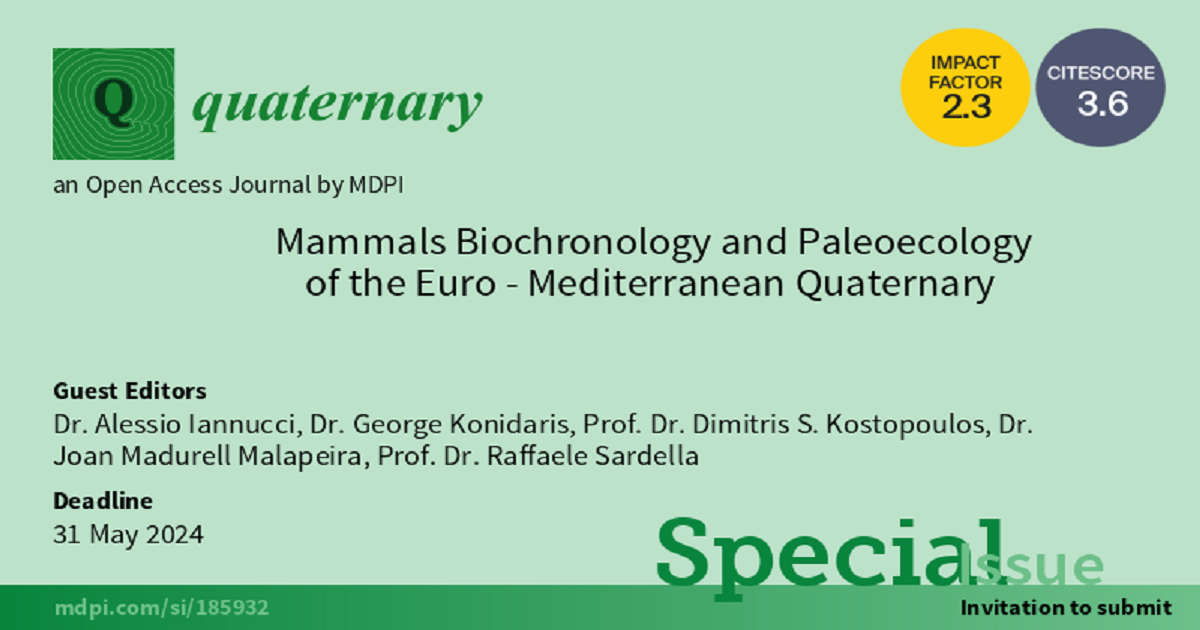- 2.1Impact Factor
- 4.1CiteScore
- 27 daysTime to First Decision
Mammals Biochronology and Paleoecology of the Euro-Mediterranean Quaternary
Special Issue Information
Dear Colleagues,
The Quaternary is a time of fundamental climatic shifts and environmental changes that highlight the need for a thorough investigation from different perspectives and at multiple scales to disentangle the factors involved in the response of the biota. In turn, recognizing bioevents (e.g., the dispersal or extinction of species) and relating them to geological time is crucial for correlating changes between distant geographic regions. The mammalian fossil record is widely used for biochronological correlations and palaeoecological reconstructions of the Euro-Mediterranean region and represents an especially important proxy for inferring the timing, pattern, and paleoenvironmental context of the earliest events of hominin dispersal into Europe. Conducting research on the response of mammals to the paleoenvironmental changes of the Euro-Mediterranean Quaternary and developing a consistent and precise pan-European biochronological framework both require the thoughtful integration of data and schemes from different geographic areas. This is especially relevant considering the wealth of new discoveries made in the last few decades and the semantic and conceptual differences in the use of biochronological terms like Mammal Ages (e.g., Villafranchian and Galerian).
This Special Issue will aim to gather contributions derived from the homonymous session organized at the XXI INQUA conference (Rome, July 14th–20th 2023), featuring research on the evolution of mammal communities and ecosystems and the identification and definition of bioevents, including taxonomic studies, and the discussion of their broader biochronological and palaeoecological significance.
Dr. Alessio Iannucci
Dr. George E. Konidaris
Prof. Dr. Dimitris S. Kostopoulos
Dr. Joan Madurell-Malapeira
Prof. Dr. Raffaele Sardella
Guest Editors
Manuscript Submission Information
Manuscripts should be submitted online at www.mdpi.com by registering and logging in to this website. Once you are registered, click here to go to the submission form. Manuscripts can be submitted until the deadline. All submissions that pass pre-check are peer-reviewed. Accepted papers will be published continuously in the journal (as soon as accepted) and will be listed together on the special issue website. Research articles, review articles as well as short communications are invited. For planned papers, a title and short abstract (about 250 words) can be sent to the Editorial Office for assessment.
Submitted manuscripts should not have been published previously, nor be under consideration for publication elsewhere (except conference proceedings papers). All manuscripts are thoroughly refereed through a single-blind peer-review process. A guide for authors and other relevant information for submission of manuscripts is available on the Instructions for Authors page. Quaternary is an international peer-reviewed open access semimonthly journal published by MDPI.
Please visit the Instructions for Authors page before submitting a manuscript. The Article Processing Charge (APC) for publication in this open access journal is 1600 CHF (Swiss Francs). Submitted papers should be well formatted and use good English. Authors may use MDPI's English editing service prior to publication or during author revisions.
Keywords
- biochronology
- bioevent
- paleoecology
- paleobiogeography
- dispersal
- faunal correlation
- faunal turnover
- mammals
- Europe
- Mediterranean
- Pleistocene
- quaternary

Benefits of Publishing in a Special Issue
- Ease of navigation: Grouping papers by topic helps scholars navigate broad scope journals more efficiently.
- Greater discoverability: Special Issues support the reach and impact of scientific research. Articles in Special Issues are more discoverable and cited more frequently.
- Expansion of research network: Special Issues facilitate connections among authors, fostering scientific collaborations.
- External promotion: Articles in Special Issues are often promoted through the journal's social media, increasing their visibility.
- e-Book format: Special Issues with more than 10 articles can be published as dedicated e-books, ensuring wide and rapid dissemination.

